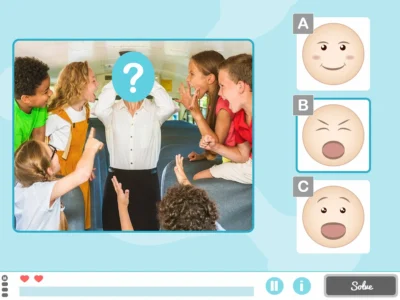Professor of psychology Mateu Servera answers outstanding questions about his presentation on neuropsychological evaluation in children with ADHD that took place on March 24, 2022.
Presentation on Neuropsychological Evaluation in Children with ADHD
University professor Mateu Servera gave a free online talk on NeuronUP Academy about neuropsychological evaluation in children with ADHD. His teaching activity focuses on Psychopathology and the assessment and intervention in childhood behavioral disorders. His research area has focused on attention deficit hyperactivity disorder (ADHD), and more specifically on Sluggish Cognitive Tempo (SCT).
At the end of the talk, a live question-and-answer session was opened. However, some questions remained unanswered; they will be answered below:
Questions about the talk
1. Paz Fernández:
- Question:
When applying the tests of the vigilance paradigm and the continuous performance paradigm, in which of the two is it more likely that children with ADHD will perform worse?
- Answer:
When applying attention tests and comparing the two styles we use most, vigilance and continuous performance paradigms, they should have more problems in vigilance.
Generally, in the vigilance paradigm they tend to have more problems than in continuous performance. Also, I should tell you that the difference more than in performance (in the final result or attentional capacity) is usually in reaction time variability. That is the key measure in children with ADHD.
An increased variability outside the norm, that is, being highly focused and appearing fast at times, and at other times very off-task, is generally better detected by reaction time variability than by the final result. But, the final result should be expected to show comparatively more problems in vigilance than in continuous performance.
2. Cynthia Canales:
- Question:
I work with children with High Ability, I regularly administer the WISC-V and have frequently detected complaints from parents and teachers about ADHD. However, either the results are within the norm, or above it; in many cases there is a downward trend in the index of working memory and processing speed. It is known that these children depend a lot on the interest or motivation that the task generates for them. For example, more repetitive tests tend to engage them less. What would be the key to detecting ADHD in this population?
- Answer:
Tests like the WISC-V may not be the best indicator to detect ADHD. This is because their performance is generally high across almost all measures. In general, when there is a tendency toward a low working memory index and processing speed, the key is usually working memory.
In High Ability, the differences are generally much smaller and it is harder to detect. Therefore, the WISC-V would not be the best assessment test, because in general they can score high or achieve elevated results on all the Number Lines.
For me, in these children the key is more clinical, that is, seeing whether their problems with attention, impulsivity and motor hyperactivity are far outside the norm, and of course cannot be explained by a lack of motivation given their high ability in the classroom. Many times, in conduct problems assimilated to ADHD, one must be very sure that they are not part of their own behavioral characteristics.
3. Inés Ferreira:
- Question:
To what extent do attentional problems invalidate tests that measure IQ, that is, low or borderline IQs that are more due to the difficulties the child has while performing the task? In that case, which test would be less sensitive to this issue I mention?
- Answer:
Yes, the attentional focusing problems of these children affect their overall IQ. However, one must differentiate that children with ADHD their overall IQ should be somewhat low, but within the normal range (approximately between 90 and 97). Thus, attentional problems should not reach the point of invalidating and causing a borderline or low IQ. If they present very low IQs, I would doubt that all of it is ADHD and one would have to consider whether the child has low cognitive abilities and is closer to that domain.
At this time, although a dual diagnosis between intellectual disability and ADHD is allowed, I am among the group of clinicians who are not very much in favor of this. That is, for me what prevails in this diagnosis is the intellectual disability. It should be noted that children with intellectual disability have attention and impulsivity problems; therefore, I would approach it in this way.
4. Emma morales:
- Question:
When there is a primary diagnosis such as Autism Spectrum Disorder, what aspects should we take into account to suspect a comorbidity with ADHD?
- Answer:
A dual diagnosis of ASD and ADHD is made very commonly. If both appear, for me ASD prevails, which is a disorder that can encompass more problems for the child than ADHD. Such as problems in the social, emotional and communication domains.
Likewise, most children with ASD present problems of inattention and impulsivity. The dual diagnosis would be useful if it is a mild ASD because one could work with the child both pharmacologically and psychoeducationally.
But aside from this particular case, in general in standard ASD, I don’t think the dual diagnosis adds much because there are ADHD-like behaviors.
5. Antonia García Jiménez:
- Question:
What should that first contact with a child suspected of ADHD in a neuropsychological assessment be like? Should certain steps be followed protocol-wise the first time they come to consultation?
- Answer:
We are in a unit where children are already referred with suspected ADHD and the parents already know why they are coming, but the children do not. A question we usually ask the child before starting is: do you know why you are here?
The answers are multiple. One response that hurt me a lot was from a 7-year-old who once said: “I’m here because I’m stupid.” It was very hard, considering he was a 7-year-old used to academic failure, being scolded a lot, punished, etc. At some point he goes through different assessments and deduces that he is stupid. For this reason, it is very important to explain to these children that they are neither stupid nor weird, they are different ways of functioning and we all have different ways of being. One should approach it from this perspective. There are several ADHD storybooks that serve to introduce these children to their possible problem, but of course one should try to eliminate any wording related to disability, disorder and those words that for children do not have much sense or relevance.
The idea is to tell them that everyone is different, that they may have some unexpected problem that prevents them from functioning better and that they should train certain things. You need to engage them so that you can attend, listen and be better understood, and focus their possible problems in this area.
6. Linda Ornelas:
- Question:
If an unspecific result has been obtained, should we follow a treatment plan focused on caring for patients with ADHD, even if there is no diagnosis as such? Should we refer to a physician immediately or do so after a few months when we perform the reevaluation?
- Answer:
There are different options; for me when we find an unspecific ADHD the plan to follow is monitoring. Training should be provided for the children’s tutors and a 3 to 6 month follow-up should be carried out approximately to see how they respond and how they progress depending on how they adapt to school, how the evaluations go, etc.
The idea is that within a maximum of 6 months we can make a definitive decision. Either we give a definitive diagnosis and this is ADHD in which case the child should receive a standard treatment, or we rule it out and see what may have happened.
If the result is nonspecific, the ideal is to place them under observation and do this follow-up rather than intervene directly because the disorder is not yet defined and because there are limitations.
7. Eliana Sánchez:
- Question:
If signs of ADHD are observed, but there is predominance of a receptive language disorder, can ADHD be considered a comorbidity?
- Answer:
All neurodevelopmental disorders currently allow a dual diagnosis among them, what happens is that one must clearly mark which is the primary diagnosis and which are secondary. I would also place receptive language disorder as the primary diagnosis. For me ADHD is, so to speak, a residual disorder in the face of the clear predominance of a more diagnosable disorder such as a language or communication disorder. One should solve that problem first before addressing ADHD. Once it is improved, then one can naturally focus on it.
Consequently, from my point of view and as I say in the case of comorbidities, ADHD is a diagnosis by exclusion, not the principal disorder unless it is the only or the priority one. If there are other neurodevelopmental or behavioral disorders present, I place them first.
8. Cecilio Pérez:
- Question:
CARAS-R gives an ICI, I usually use it in assessments with children under 8 years old, do you not recommend it for any specific reason? What is your opinion of the R2 for children over 8? I use these two. What differentiates them from EMI or STOP?
- Answer:
The CARAS-R test is a perceptual test from my point of view. It has not given us very good results in attention. We used it at the beginning; it has been several years since we used it. Although I am not an expert, I was not completely convinced. Once we tried it we switched to CPT tests and specific vigilance tests. I have no more experience than its early use, but I consider that in ADHD both for research and by reference the specific attention tests are more recommendable.
Our ways of choosing tests are those that we see have good research support or that we have used in clinic and that respond quite well.
The EMI and STOP tests are two impulsivity tests, one cognitive and one behavioral. On the one hand, the EMI is a test in which the child has to develop a problem-solving strategy. On the other hand, the STOP test is a more direct test. It is a very experimental motor control test where the child is subjected to a series of stimuli to which they learn to respond. Subsequently, there is an auditory signal in which they must inhibit their response
9. Belén Prieto-Corona:
- Question:
Do you not consider it useful to add the assessment of executive functioning in an ecological form using the BRIEF?
- Answer:
Totally agree in incorporating the BRIEF into the protocol. In addition, we use Barkley’s executive functioning scale for children. It is very similar to the BRIEF, which I also find ideal and which should be part of the assessment. Likewise, ecological executive functioning tests distinguish ADHD very well.
10. Natalia Astudillo:
- Question:
Is there a protocol of this IMAT style of neuropsychological evaluation in children with ADHD for ASD? Is it possible to use non-standardized tests in my country if an appropriate standardized one cannot be found?
- Answer:
We do not have an IMAT protocol for ASD, since we do not usually work with this disorder. However, we do address some ASD measures in children with comorbidity with ADHD. There are indeed several tests derived from many theories that touch on this topic. There are quite a few tests that can even be found openly available.
11. Patricia Vázquez:
- Question:
What do you think about some opinions of other professionals in Spain who say that ADHD is a problem of deparentalization?
- Answer:
There are movements opposed to considering ADHD as a disorder. Such as denialist movements or conditional movements. My way of understanding the problem is a neuropsychological position.
Certainly, there is a basis and a functioning at the neuropsychological level that does not work well in these children. This should be the basic diagnostic point. Although we do not have a definitive test, we have much research evidence that, for me, is sufficient to consider this the starting point. After that, that starting point is altered by environmental factors, such as parenting, education, the school setting, etc. Of course, ADHD is a disorder very sensitive to environmental conditions, but not from the causal point of view. One thing is to have moderating factors of the problem that must be taken into consideration, and another is risk factors.
In conclusion, I would consider ADHD as a neurodevelopmental problem highly influenced by contextual problems, among them the parental domain.
12. Juan Carlos Gutiérrez:
- Question:
What is your opinion regarding the use of Nesplora for the assessment of ADHD?
- Answer:
I find it an interesting tool. However, it is more complex than computer tests, obviously. It also offers a report on head and child mobility during the tests which I find interesting and I like a lot.
Nesplora has published papers giving diagnostic sensitivity and specificity indices that are quite high, which I believe should be replicated not only by authors from the Nesplora field. Likewise, I consider it a good attention test that should be used complementarily with others.
On the other hand, one could say that it is a more expensive test than others and that similar results can be obtained with other attention tests.
13. Maria Fernanda Misti:
- Question:
Can this neuropsychological evaluation protocol for children with ADHD be used after a neurologist refers them to us, or would the evaluation we perform constitute the process to give the diagnosis as such?
- Answer:
The protocol we use is by referral. Children come referred from all areas; it could be school, by parental suspicion, or referred by a professional. For example, a pediatrician, a psychologist or a neurologist who requests an evaluation from us. When a professional asks us for an evaluation, a report is made and subsequently the professional sees our proposal and then it is they who carry out the intervention.
If the child is referred by a professional, we do the evaluation work and the professional carries out the intervention.
14. Patricia De la Vega:
- Question:
What diagnosis would be given to children under 6 years old when ADHD becomes evident?
- Answer:
We do not make a diagnosis before age 6. In this case, we place the child under what would be observation. That is, they would not have a specific diagnosis. However, if the child shows difficulties in some areas they are followed up more specifically. Once they start primary school the diagnosis would be made.
15. Daniel Óscar Rodríguez:
- Question:
Children with ADHD and autism, could IMAT be used?
- Answer:
It could be used as long as they are children with mild autism or Asperger. I insist on what I said before: if there is a clear diagnosis of autism the central point of the intervention would be that. What ADHD could contribute as a comorbidity is relative.
In this case of children with ADHD and mild autism we have applied the IMAT protocol and we have not had problems.
16. Alejandra Olea:
- Question:
Can assessment instruments validated in each country that evaluate functions similar to those mentioned here be used, following the IMAT protocol for the neuropsychological evaluation of children with ADHD?
- Answer:
We use American Number Lines but validated in Spain. Likewise, we use both norms, the American and the Spanish. We compare them in reports and they are quite similar. We work to try to adapt the norms to the environment as much as possible.
In some countries there is validation work for each of the tests and in others there is not. One would have to search the publication journals to see if these results appear.
17. Marta Cid:
- Question:
I have received a report in which the diagnosis is ADHD oppositional defiant disorder with Medication prescribed. But, for Right Now only the Medication is maintained. Is this correct or should there be follow-up?
- Answer:
If only Medication appears, it must be a type of Medication for ADHD, which is usually monitored every so often. For this reason, there should also be some control by the physician.
In addition to the Medication, there should also be a part of parent training, training for educators and direct work with the child on control and impulsivity. That is, there should be treatment simultaneous to the Medication.
18. Irma Fernández:
- Question:
Do sensory alterations occur in ADHD?
- Answer:
It is not a usual characteristic of ADHD. If they appear, we would have to see if there is any other neurodevelopmental comorbidity that causes them directly. For example, the autism spectrum or another neurodevelopmental disorder.
19. Alma Isabel Hernández:
- Question:
Can the Moxo and Aula Nesplora tests be decisive, by themselves, to speak of attention deficit?
- Answer:
Both are good attention tests. In my opinion, they are not sufficient to determine ADHD by themselves, even if results are very spectacular in both. In ADHD tests like these, if we obtain a positive result and they have been applied correctly, generally something is happening. But, if they are negative, nothing can be ruled out.
20. Ana Pareja:
- Question:
Does this neuropsychological evaluation protocol for children with ADHD not include the CABI as a questionnaire for parents and teachers?
- Answer:
The CABI test is quite new and we are increasingly incorporating it into the neuropsychological assessment protocol for children with ADHD. Right Now we are in an ongoing project and we trust that in the coming years we will obtain a standardized CABI for the entire Spanish territory from 6 to 18 years old. For now, what we have we are using, but until we have it more developed it is not the key test.
21. Susana Liszka:
- Question:
What determines the use of pharmacological medication in ADHD in your experience?
- Answer:
Fundamentally, in relation to the main guidelines on the subject, pharmacological medication does not have to be the first choice. However, it is a very good alternative when ADHD occurs at a moderate to severe level and when psychoeducational intervention is very difficult. Also, Medication is usually used when there are comorbidities that may border on severe behavioral problems.
Likewise, since Medication is not a definitive solution but a symptomatic solution, it can be introduced whenever you want. For example, you can start with a psychoeducational intervention with the child and if after 2 or 3 months you see that it is not going well, you can incorporate pharmacological Medication in an appropriate form and manner.
22. Daniela Chamblas:
- Question:
Within the cognitive assessment, could it be assumed that children with ADHD present more deficient or slower cognitive performance?
- Answer:
Some of them do. Especially the more purely inattentive ADHD, since slowness and deficiency in focusing becomes more evident. Even more so than in the impulsive hyperactive ones, whose own activity sometimes allows them to have better cognitive performance.
23. Carolina González:
- Question:
If there are marked attentional difficulties both auditory and visual and slightly altered WM VP, but marked memory difficulties are observed, is this still considered ADHD?
- Answer:
The neuro part is complementary. You have to start by looking at the behavioral profile of the protocol applied to determine what is happening. Once we know what is happening at the behavioral level, we proceed to analyze the neuro part. In this part, we look for an alteration, but not specific to ADHD.
Altered neuro profiles are not specific to one area. That is, there are children with ADHD where working memory can be very altered and others where attention is. One should not seek a direct protocol that yields ADHD, but look at the spectrum and see there whether that alteration occurs.
24. Almudena Ibáñez:
- Question:
In the inattentive subtype there may be a behavioral profile that is not very relevant and, in my opinion, it is the most difficult to diagnose; how would this subtype function in your model?
- Answer:
The inattentive type goes much more unnoticed mainly because it can fail in the behavioral profile. Also, because little involvement can be demonstrated in the behavioral profile. In the behavioral profile where ADHD is usually noticed is in inattentive behaviors. In that area both parents and educators usually detect that something is wrong. This is because the child is distracted, inattentive, lost in their world, often confuses, etc. And it is at this point where the problem is usually detected on the behavioral side. Although, evidently, it goes more unnoticed because it can be a child without impulsivity or hyperactivity.
We would set the behavioral inattention part and then look at what is happening on the neuro side. A good suggestion would be to introduce the measure of sluggish cognitive tempo.
25. Fabio Silva:
- Question:
Do you think the D2 Test and the Trail Making Test are good to assess a case of ADHD?
- Answer:
Regarding the D2 test, I used it at the beginning but it did not end up working for us. It detected very little, at least in children. On the other hand, the Trail Making Test we have used more in adults sometimes, but not in depth. This test has not convinced us either. In my case I would not recommend either of the two tests because I believe there are other much more specific attentional tasks.
26. Marcela Gómez:
- Question:
Sometimes a child’s way of interacting in the different groups to which they belong (family, school, social or sports club and others) is not consistent. There are also groups that normalize behaviors so that it does not represent a symptom for one group and does for another group. How is this handled in these cases?
- Answer:
When we do the IMAT neuropsychological evaluation protocol for children with ADHD, sometimes we obtain evaluations from parents, school tutors, extracurricular teachers and other areas. Information can be collected from 3 or 4 different evaluators who interact with the child in different environments. This can lead to a lack of consistency. We find this with some frequency.
You have to be very careful, because, as you know, ADHD has a syndromic character. That is, it has to occur in two or more environments. And sometimes this condition is often not taken into account.
If it is only ADHD in one environment we put it in serious doubt, and technically the diagnosis could not be made. However, we review the case and are very attentive to what happened with the other evaluators.
27. Daniela Chamblas:
- Questions:
Are training courses offered to certify in applying the IMAT test? Who can be certified?
- Answer:
No, we have some professional update courses, but none specific to IMAT. We have had people who spend a few months in our unit to see how we work, and they are usually students.
28. Andrea Lazcanoiturburu:
- Question:
What would you do if the school does not cooperate and does not respond to the questionnaires?
- Answer:
It is a problem, since it is necessary to demonstrate that the problem occurs in at least two environments. And the classic environments for the child are home and school. Therefore you need the school’s cooperation. If the tutor does not respond, we speak with the school or look for another teacher who has had at least 3 months of interaction with the child. Once the tutor is clear about what the child is like, they should answer the questionnaires.
If you liked this article about the talk on neuropsychological evaluation in children with ADHD, you may also be interested in the following information:
“This article has been translated. Link to the original article in Spanish:”
Evaluación neuropsicológica en niños con TDAH – Respondiendo dudas








 The mental health of healthcare workers
The mental health of healthcare workers
Leave a Reply